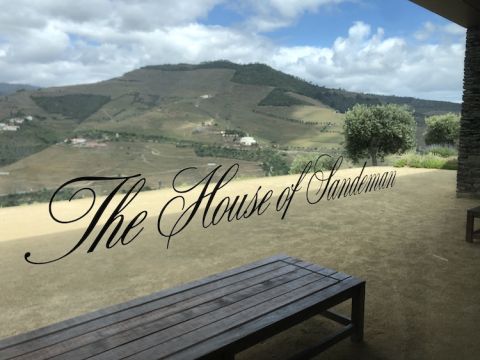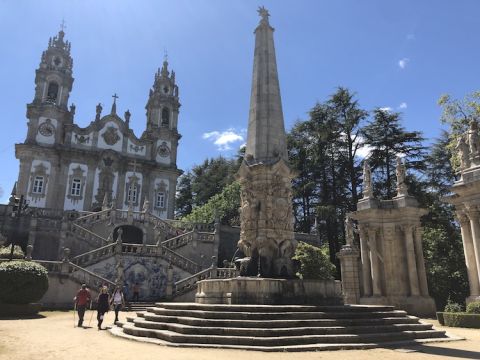No one can dispute the fact that the Douro Valley is breathtaking. As I stand on top of a paddleboard, amidst the darting grey mullets just beneath the water and the echoing birds flying over the ancient vineyards, I watch the sun set over the town of Regua. You ask for a wine lover’s guide and here it is – but man, the Douro is so, so much more than that.
When my partner and I planned this trip, it started off as a race to visit as many quintas as possible. Yet the Douro has a way to subdue your inner tourist, especially in the calm, serene surrounds and understated elegance of our hotel, Lamego Hotel and Life. Our mornings begin with an indulgent breakfast filled with local pastries, and our afternoons were spent either gazing at the view from the hotel patio while sipping on white port and tonic, or lazing at the pool. The hotel offers a host of activities through third parties, including paddleboarding, hikes, and even cooking classes.
Of course, ultimately, this trip is about wines. The three quintas I recommend are all noteworthy in their own ways, and have selling points that would attract different people.
The first is Quinta do Seixo, one of the most traditional vineyards owned by Sandeman, part of Sogrape Vinhos. This is dead smack in the middle of Cima Corgo (see picture top right), a subregion of the Douro Valley demarcated area known for its production of the best port wines. Its climatic temperament is nature’s Goldilocks, not as cool and rainy as Baixo Corgo to the west, and not as hot and continental as Douro Superior to the east. Vines here are old, mostly over 40 years, producing some of the lowest harvest yields and concentrated grapes in the world.
Upon entry to the estate, our guide greets us spectacularly in the distinctive Sandeman cape and hat, and for a moment I think I am being led to a Disney ride for port. There are some kitchy moments, but it is all superseded by our incredibly passionate guide. He speaks about the raging Douro River that befell many a rabelo boat before the dam was built; the unforgiving yearly bushfires that devastate the region; the unyielding matron of the Douro Valley, Dona Antonia Ferreira; the tale of the last surviving ungrafted vines of the Douro. His stories flitted between legends, reality and town prattle, giving a great sense of community spirit and conviviality. The tour concludes in their tasting room, where ceiling to floor windows (see below) open up to the Douro’s undulating hills. The view is worth the trip alone. There is a friendly dog, once an abandoned rabbit hunter whom the team at Quinta do Seixo adopted, that roams the patio soliciting pets and hugs from patrons.
The next quinta we visit is Quinta do Bonfim, an esteemed vineyard part of Symington Family Estates, who own a host of Port houses including Warre, Graham and Dow. Besides cellar tours, Quinta do Bonfim offers a self-walk vineyard tour, which includes a detailed map, a panama hat, and a water bottle. If one is better prepared than we are, a picnic basket can also be organised.
We explore the different vineyard configurations that are a testament to the Douro’s history – the walled stone terraces of old, the patamares that allowed for mechanisation at a time when manpower was lacking and, finally, the vertical vineyard system, a solution to increase acreage onto the more slanted hillsides. It is a lovely mini-hike, one to take at your own pace and in your own peace, with the scent of orange blossom guiding the path.
Of course, there is a tasting at the end, and it concludes with a 1985 Dow vintage port. Pencil shavings, dusty earth, slight camphor, gravel and cedar, with a core of dried plums and blackcurrant drive the palate. The quintessential sweetness of port is an afterthought there, a wisp of interest just to entice you for another sip. If one has not tried an aged vintage port, this is the time, place and vintage to do it.
The third quinta we visit does not lie within the Cima Corgo zone. It is in Baixo Corgo, close to the city of Lamego. Instagram photos abound of Quinta da Pacheca’s hotel, where massive wine barrels have been converted into stylish accommodation (on the skyline above). Quinta da Pacheca specialises in still, unfortified wines, growing acres upon acres of local varieties as well as international varieties. It is one of the very few estates once ruled by a woman, Dona Mariana Pacheco Pereira, and one of the first to bottle their DOC status wine under their own label. They also showcase an important landmark in the Douro region: a stone pillar, called marcos pombalinos, sits outside the visitors' centre, marking the Douro as the first demarcated wine region in the world in 1756. The Marquês de Pombal, in an effort to safeguard the port wine trade, bounded the region with 335 of these stone pillars, of which only a third survive.
Next we entered the winery, where rows of low granite lagares, or treading tanks, line the room. Our guide informs us that tradition dictates that they still tread grapes with bare feet. He explains the ritual of the tread – a band is set up front and centre, feet are cleaned with plain water, and the tread begins as a dance. However, his stories about the yearly ceremony point to a greater force than just ‘tradition’. It is a celebration of a vintage concluded, an imparting of the many uncertainties, worries and risks endured, a final act to reminisce over after a year’s work. Treaders dance in the lagares, knee-deep in grape must, while joyful music accompanies the clinking of glasses filled with wine from yesteryear. It is a thanksgiving, a bonding, a blessed opportunity to stoke camaraderie.
Needing a juice-free afternoon, we explore the lively medieval city of Lamego, cobblestoned and sun drenched. The city houses one of the most beautiful churches I have seen. A set of ornate, azulejo-decorated stairways zigzag upwards, leading to the Santuário de Nossa Senhora dos Remédios, Church of Our Lady of Remedies (below). We climb 600-plus steps, stopping at each landing to take in the view, bask in the sun, or walk around the secret gardens. The tree-lined church is tourist-free, a refuge for those who complete the pilgrimage.
The green hills and scenic countryside also seduces hikers, and the Tourist Centre at Lamego is more than happy to point one to the best spots. We decide on an easy three-hour circular trail starting in the little village of Mazes south of Lamego. More determined hikers could tackle the two to three-day hike that starts at Pinhao, a village that houses some of the most important quintas and acts as the ferry dock where rabelos filled with port pipes set sail to the maritime city of Porto. Pinhao is also the end point for the N222 Port and Douro Wine Route that starts in Regua, hailed as one of the best drives in the world. It is more beautiful than is advertised, with many roadside stops for taking photos.
I find food in the Douro to be sumptuous yet casual affairs, always focused on local recipes served with a carafe of red. We visit Taberna do Porfirio Garcon Douro in Lamego, within the main plaza, where a fabulously porky meal is demolished by us – do not miss the local sausage, alheira, made with meat and bread. Another restaurant beside the Catedral de Lamego, Casa Felipe, serves the best grilled octopus and arroz de salpicao. A stunning lunch at the Wine House Restaurant in Quinta da Pacheca gives traditional Portuguese food a face lift, deliciously matched with wines produced at the estate. And foodies should definitely experience the hospitality and elevated cuisine of Rui Paula’s DOC restaurant in Folgosa with its unobstructed view of the Douro river.
But the absolute highlight for us is the once-in-a-lifetime, bucket list-worthy opportunity to paddleboard on the Douro organised by our hotel. Other providers such as Porto SUP Tours abound. We stand on our paddleboards and flow over the soft currents of the Douro River with our guide. He speaks of his family, of himself, born and bred by the river, surrounded by the might of nature. He speaks of his friends, who craved the bustle of the city only to return home, drawn by its enigmatic hardiness. As the sun begins to set, and we paddle downstream, I can see it. The Douro is not just a tourist hotspot. Its allure isn’t just its sacrosanct beauty, nor its historic and famous wines. Its heart is in its sense of place, shaped by centuries of people who toiled and risked, who dreamt and built, the Douro that is today.















